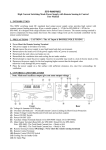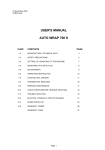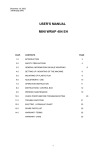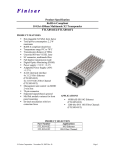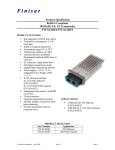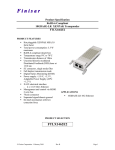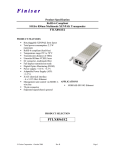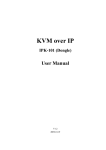Download CAEN N145
Transcript
Technical Information Manual Revision n. 0 21 April 1999 MOD. N 145 QUAD SCALER AND PRESET COUNTER/TIMER C.A.E.N. Document type: User's Manual (MUT) Title: Mod. N145 Quad Scaler and Preset Counter/Timer Quad Scaler and Preset Counter/Timer Revision date: 20/04/1999 Revision: 0 TABLE OF CONTENTS 1. MODEL OVERVIEW.......................................................................................................................... 4 2. SPECIFICATIONS .............................................................................................................................. 6 3. PERFORMANCE DATA..................................................................................................................... 7 3.1. 4. 5. 6. POWER REQUIREMENTS .................................................................................................................... 7 PRINCIPLES OF OPERATION ......................................................................................................... 9 4.1. SECTIONS 1 TO 4 .............................................................................................................................. 9 4.2. SECTION 5 ....................................................................................................................................... 9 APPLICATION NOTES .................................................................................................................... 11 5.1. GATED UP-COUNTING ..................................................................................................................... 11 5.2. 16- OR 24- DIGIT UP-COUNTING..................................................................................................... 11 5.3. FREQUENCY MEASUREMENTS.......................................................................................................... 12 5.4. DIVIDER ........................................................................................................................................ 12 5.5. DELAY UNIT .................................................................................................................................. 12 5.6. MEASUREMENT ACCURANCY .......................................................................................................... 13 TEST PROCEDURES........................................................................................................................ 14 6.1. INTRODUCTION .............................................................................................................................. 14 6.2. EQUIPMENT REQUIREMENTS ........................................................................................................... 14 6.3. SEQUENCE OF OPERATIONS ............................................................................................................. 14 6.4. TEST OF SECTION 5......................................................................................................................... 15 6.5. TEST OF THE DISPLAYS (SECTION 1 TO 4) ......................................................................................... 16 6.6. TEST OF THE COMPLETE MODULE .................................................................................................... 16 LIST OF FIGURES FIG. 1.1 – MOD. N145 FRONT PANEL .............................................................................................................. 5 FIG. 3.1 – SECTION 5 - TIMING DIAGRAM ........................................................................................................ 8 Filename: N145MAN Number of pages: 16 Page: 3 C.A.E.N. Document type: User's Manual (MUT) Title: Mod. N145 Quad Scaler and Preset Counter/Timer Revision date: 20/04/1999 Revision: 0 1. Model overview C.A.E.N. Mod. N145 is a double unit NIM module that includes four independent 8-digit up-counters, plus a fifth 7-digit down-counter that can be used either as a preset counter or as timer. The counters can have different operating modes and can be variously interconnected, thereby making the module a flexible and powerful tool for several applications involving time, frequency and ratio measurements. All counters can accept either TTL or NIM inputs. All control and output signals are standard NIM. The maximum input frequency is 80 MHz(∗ ) and the minimum pulse width is 8 ns(∗ )for the up-counters, and respectively 30 MHz and 15 ns for the down-counter. All input and output connectors as well as all the control switches are located on the front panel. All input and output connectors are LEMO 00 type. (∗ ) Minimum guaranteed performance data (∗ ) Minimum guaranteed performance data Filename: N145MAN Number of pages: 16 Page: 4 C.A.E.N. Title: Mod. N145 Quad Scaler and Preset Counter/Timer Revision date: 20/04/1999 Revision: 0 NIM IN GATE TTL CH1 NIM IN GATE TTL CH1 NIM IN GATE TTL CH1 NIM IN GATE TTL CH1 NIM IN TTL CH5 CH1 CH2 CH3 CH4 COMM RESET Document type: User's Manual (MUT) NORMAL GATE GT+ CLR Fig. 1.1 – Mod. N145 Front Panel Filename: N145MAN Number of pages: 16 Page: 5 C.A.E.N. Document type: User's Manual (MUT) Title: Mod. N145 Quad Scaler and Preset Counter/Timer Revision date: 20/04/1999 Revision: 0 2. Specifications SECTIONS 1 AND 3 INPUTS 2, one NIM and one TTL, 50 Ω impedance. GATE 2, NIM bridged input ports, high impedance, internally connected. Free port must be terminated on 50 Ω SECTIONS 2 AND 4 INPUTS 2, one NIM and one TTL, 50 Ω impedance. GATE one NIM input, 50 Ω impedance. CARRY one NIM output. Generates apulse when counter has fully cycled (transition 99,999,999 to 0). RESET one NIM input, clears sections 1 to 4. Same effect is obtained, for each section, with the individual RESET pushbuttons. SECTION 5 INPUTS 2, one NIM and one TTL, 50 Ω impedance. LOAD one NIM input. Loads counter with value preset on the thumb wheel switch display (same effect with LOAD pushbutton). OUT 2, NIM outputs, these are true(∗ )as long as counter contents are different from zero. END MARKER one NIM output, a pulse generated when the counter contents become zero. Pulse width is adjusted with trimmer between 50 ns and 1 µs. (∗ ) NIM level 1=-800 mV=TRUE Filename: N145MAN Number of pages: 16 Page: 6 C.A.E.N. Document type: User's Manual (MUT) Title: Mod. N145 Quad Scaler and Preset Counter/Timer Revision date: 20/04/1999 Revision: 0 3. Performance data 3.1. INPUT MAX. FREQUENCY MIN. PULSE WIDTH sections 1 to 4 80 MHz 8 ns section 5 30 MHz 15 ns load 10 ns reset 10 ns Power requirements +6 V 2.5 A −6 V 150 mA All connectors are LEMO 00 type. Filename: N145MAN Number of pages: 16 Page: 7 C.A.E.N. Document type: User's Manual (MUT) Title: Mod. N145 Quad Scaler and Preset Counter/Timer Revision date: 20/04/1999 Revision: 0 NIM INPUT LOAD 40 ns min 10 ns min DISPLAY DATA 0 3 2 1 0 120 ns dead time OUT ≈ 35 ns ≈ 35 ns END MARKER Trimmer adjustable Fig. 3.1 – Section 5 - Timing Diagram Filename: N145MAN Number of pages: 16 Page: 8 C.A.E.N. Document type: User's Manual (MUT) Title: Mod. N145 Quad Scaler and Preset Counter/Timer Revision date: 20/04/1999 Revision: 0 4. Principles of operation 4.1. Sections 1 to 4 The counters can operate in three distinct modes, which are: NORMAL Free running. The counter is incremented by the input pulses. GATE The counter is incremented by input pulses only if the GATE input is true. GATE + CLEAR Same as GATE mode, however the leading edge of the GATE input clears the counter. The modes are manually selectable, for each section, by the switches on the bottom row of the front panel. The up-counters are reset to zero, either manually (individually for each section) by acting on the RESET pushbuttons, or electrically (common to all sections) by means of a NIM pulse on the COMM RESET input. Sections 1 and 3 have two NIM high impedance GATE bridged inputs which are internally connected; a NIM input must be terminated with a 50 Ω impedance at the other port. Sections 2 and 4 have one 50 Ω NIM GATE input and one CARRY output. The CARRY output generates a NIM pulse when the counter has fully cycled (transition from max counter value to zero). This can be used to extend the counters' range by cascading sections, as shown later. 4.2. Section 5 The fifth counter is a 7-digit counter that can operate as a PRESETTABLE DOWNCOUNTER or as a TIMER. Either mode is selected by the manual SOURCE SELECT switch (labelled COUNTER/TIMER). In COUNTER mode the counter is decremented by the external (NIM or TTL) input pulses. In TIMER mode the counter is decremented by an internal precise quartz clock, independently of input pulses. The frequency is selectable by acting on the TIMER switch and can be set to 1 KHz (1 ms) or to 1 MHz (1 µs). In either mode, the counter must be initally preset to the desired value by acting on the Thumb wheel switches and then by loading the datum either manually with the LOAD pushbutton or electrically with a NIM pulse. At the leading edge of the first input pulse Filename: N145MAN Number of pages: 16 Page: 9 C.A.E.N. Document type: User's Manual (MUT) Title: Mod. N145 Quad Scaler and Preset Counter/Timer Revision date: 20/04/1999 Revision: 0 the OUT ports become true. The counter is then decremented by the input pulses unntil zero is reached. At the trailing edge of the last input pulse: the OUT outputs are reset to FALSE (0 V) the END MARKER output generates a NIM pulse the length of which can be adjusted between 50 ns and 1 µs by acting on the trimmer next to the END MARKER connector. This arrangement allows direct use of the OUT ports as GATE inputs to the counters of section 1 to 4. CYCLING of Section 5 is controlled by the SINGLE/REPEAT switch, which is labelled SGL/RPT. In SINGLE mode the selected function (PRESET COUNTER or TIMER) is performed only once, until zero is reached for the first time. The counter must then be restarted by a new load operation. In REPEAT mode a few seconds after zero is reached the counter re-triggers itself automatically, by performing an automatic LOAD, and a new cycle is restarted. This procedure is repeated indefinitely. Note that by connecting the END MARKER output to the LOAD input the counter is cycled without the time delay of the REPEAT mode. Filename: N145MAN Number of pages: 16 Page: 10 C.A.E.N. Document type: User's Manual (MUT) Title: Mod. N145 Quad Scaler and Preset Counter/Timer Revision date: 20/04/1999 Revision: 0 5. Application notes 5.1. Gated up-counting When in NORMAL MODE, the counters (sections 1 to 4) do not require a GATE input. However, when in GATE (of GATE+CLEAR) mode, a NIM signal must be supplied at the GATE input of each counter used. NOTE: this signal must be terminated with a 50 Ω impedance at the other GATE bridged input, on sections 1 or 3. A single GATE signal can be fed in parallel, to more than one channel by using jumper cables between sections 1 and 3, and sections 2 and 4; if the last section is either 2 or 4 then this also provides the correct 50 Ω cable termination. For example, sections 1 and 2 can share a GATE by feeding the external GATE signal to the GATE input of section 1 and then connecting a jumper between the other GATE output of section 1 to the GATE input of section 2, which has a 50 Ω impedance. Similarly, it is possible to connect up to three sections (for instance #1 with #3, and then #3 with #2 or #4) with a single external GATE input cable and two jumpers. The OUT signal of section 5 can be used as the GATE input to the counters. The double OUT connector permits parallel GATE feeding of all four sections, as described above. Using a common GATE to more sections allows direct ratio measurements among the inputs to the various channels. 5.2. 16- or 24- Digit Up-Counting It is possible to increase the up-counting range to 16 or 24 digits by using the CARRY outputs of sections 2 and 4. For instance, 16-digit up-counting is obtained by connecting the CARRY output of section 2 to the NIM input of section 1. When the counter of section 2 has fully cycled (transition 99,999,999 to zero) the CARRY output supplies a NIM input pulse to section 1, and so on. Thus section 1 will show the most significant digits, and section 2 the least significant digits of the counting operation. Similarly, for 24-digit up-counting, the CARRY output of, say, section 2 may be connected to the NIM input of section 4; the CARRY output of section 4 may then be fed to the NIM input of section 1 or 3. Filename: N145MAN Number of pages: 16 Page: 11 C.A.E.N. Document type: User's Manual (MUT) 5.3. Title: Mod. N145 Quad Scaler and Preset Counter/Timer Revision date: 20/04/1999 Revision: 0 Frequency measurements This is a way of making relative frequency measurements. By using section 5 in TIMER MODE, it is possible to make an absolute frequency measurement, with a variable integration time. For that purpose: • select the clock rate: with the TIMER switch: • ƒ=1/τ (τ=1 µs or 1 ms) select a value N (for instance a power of 10) with the thuimb wheel switches. The integration time is then: Ti=Nτ • use the OUT signal as the GATE input to the selected section 1 to 4 Counter(s), operating in GATE+CLEAR mode. The external input frequency is then given by: where 5.4. ƒi=(Mc)/(Nτ) is the number of pulses received by the Counter while GATE is active. Divider Section 5 can also be used as a divider of an external input sequence. For that purpose: 5.5. • connect the END MARKER output to the LOAD input. • Select the input / output ratio R by setting the thumb wheel switches. • Connect the external input at the section's input port and take the (decimated) NIM output at the OUT ports. That is, a pulse is generated at the OUT port every R pulses at the input. Delay unit Section 5 can also be used to generate a delayed pulse (at the END MARKER output) or transition (at the OUT ports). An absolute delay can be otained with section 5 in TIMER Mode. The duration of the delay is Td=N.τ where N is the preset value on the Thumb wheel switch display, and τ is the internal clock period. The time delay is the elapsed time between the time of the leading edge at the LOAD input and leading edge either at the END MARKER output or at the OUT connectors. See the next section for accuracy. With the counter in COUNTER Mode, a relative delay (in terms of number of pulses) can be obtained between the NIM or TTL input and the END MARKER or OUT connectors, after the preset number of input pulses have been counted. Filename: N145MAN Number of pages: 16 Page: 12 C.A.E.N. Document type: User's Manual (MUT) 5.6. Title: Mod. N145 Quad Scaler and Preset Counter/Timer Revision date: 20/04/1999 Revision: 0 Measurement accurancy For the previous applications, it is important to remember that with any measurement made with a counter on a periodic waveform there is always an intrinsic uncertainty of one pulse. This is due to the fact that, depending on the position of the start of the measurement window with respect to the period of the waveform, one pulse may or may not be totally included, and thus counted for. This also applies to the uncertainty of the selection of the reference time window. The uncertainty of the measurement of an absolute time delay is therefore equal to , the clock period. For frequency measurements it is: ∆ƒi=ƒmax−ƒmin=(Mc)/(Nτ)−(Mc-1)/(Nτ)=1/(Nτ) where ∆ƒi is the absolute frequency uncertainty. The relative frequency uncertainty is then: ∆ƒi=1−(Mc) and since for a given (constant) frequency Mc(=Nƒτ) is proportional to N, the percent accuracy is increased by increasing N. Filename: N145MAN Number of pages: 16 Page: 13 C.A.E.N. Document type: User's Manual (MUT) Title: Mod. N145 Quad Scaler and Preset Counter/Timer Revision date: 20/04/1999 Revision: 0 6. Test procedures 6.1. Introduction Mod. N145, as all other CAEN products, was designed by out engineers with particular attention to reliability. It was built with the utmost care and thoroughly tested to meet and exceed the reliability standards for this class of equipment. Proper handling of the unit should result in long-lasting trouble-free operations. The following test procedures are given here essentially for initial equipment check-out or simple troubleshooting should a malfunction be suspected. They provide the rational for simple yet consequential tests to single out the possible causes of problems. If these tests do not help you out, or if a major malfunction is detected, please refer to C.A.E.N. Technical Service. The tests can be made with general-purpose equipment as indicated below; however they can also be conveniently performed using CAEN modules. In the following, italic text is used to describe equipment and procedures specifically applicable with CAEN products. 6.2. 6.3. Equipment requirements • One Dual Trace Oscilloscope, • one Fan-out of four device (4-way discriminator, Mod. N84), • one Waveform Generator (up to 100 MHz), • two delayed Pulse Generators, (or three Dual Timers, Mod. N93B) Sequence of operations An overall testing of the module involves three steps. 1. Test of section 5, 2. Test of the Displays, 3. Test of Complete Module. Filename: N145MAN Number of pages: 16 Page: 14 C.A.E.N. Document type: User's Manual (MUT) 6.4. Title: Mod. N145 Quad Scaler and Preset Counter/Timer Revision date: 20/04/1999 Revision: 0 Test of section 5 Test N°1 (No External Connections) For each digit, preset all values (0-9) and, by pressing LOAD, check that the value is correctly loaded into the LED display. Test N°2 (TIMER mode - Cycle Switch on SINGLE) This test is meant to check in a compact way the proper operation of several functions. These are the operations of the internal quartz, the LOAD, the OUT and the END MARKER functions. To perform the test, generate with the Delayed Pulse Generator a NIM pulse triggered by, but not to be overlapped to, the END MARKER pulse, with a variable delay from the leading edge of the END MARKER and a minimum pulse width of 10 ns. This pulse is used to drive the LOAD input. To generate this pulse with CAEN hardware connect the END MARKER output to the input of one section of a Dual Timer, which acts as a variable delay; the end marker of this section is connected to the input of the other section. Use the end marker of this last section as the LOAD input of module N145. The delay must be such that the LOAD pulse must take place when the END MARKER pulse is finished. Now preset the value of 1 µs and press LOAD. Model N145 must cycle; the LED displays must go to zero and the OUT signal, checked with a scope, must be equal to 1 µs + the transit time of the counter's chain (about 80 to 100 ns). Check also that the END MARKER output can be made to vary between 50 ns and 1 µs. Preset any time value, both in µs and in ms, and check with the scope that the Out signal has the preset length. Perform this test with the cycle switch also in REPEAT mode; the correct value should appear about every two seconds. Test N°3 (COUNTER Mode - Cycle switch on SINGLE) This test is similar to the previous one, the only difference being that the source of the test clock is this time external. This is to test that the COUNTER mode operates properly. Drive the counter at its NIM input with an oscillator with a variable frequency up to 30 MHz. The set-up is just as described for Test N°2. Preset on the thumb wheel switch a value N. Check on the scope that the OUT signal has a time length of where is the external clock period. Check also the TTL input in the same manner. Filename: N145MAN Number of pages: 16 Page: 15 C.A.E.N. Document type: User's Manual (MUT) 6.5. Title: Mod. N145 Quad Scaler and Preset Counter/Timer Revision date: 20/04/1999 Revision: 0 Test of the displays (section 1 to 4) Test N° 4 With an oscillator, send pulses, at a variable clock rate, at the NIM input of each section and check that the LED displays are correctly showing all digits and that the CARRY be generated at the 9-0 transition. Test N°5 Purpose of this test is to check that the counter does not accept an input pulse before the leading edge of the GATE signal (within 2 ns). For that, use two Delayed Pulse Generators to obtain two pulses with variable mutual delay. With CAEN hardware, use a Dual Timer configured as oscillator and take two outputs and send them to two different delay chains; then drive the two sections of a second Dual Timer. Preset the widths of the output pulses to 100 ns and 40 ns respectively. Send the 100 ns signal to the GATE input and the 40 ns signal to the NIM input of the N145. (Provide matching 50 Ω impedance if required). Select GATE+ CLEAR mode and, acting on the delay chains, verify that the display counts one pulse until the leading edge of the input is within 2 ns or less from the leading edge of the GATE. 6.6. Test of the complete module These tests are performance checks on the operation of the counters. Test N°6 With an oscillator and a fan-out of 4 make four 8 ns pulses. (Use cables of equal length). Drive the four NIM inputs of sections 1 to 4. Set GATE+CLEAR mode and use section 5 (set to TIMER mode and REPEAT mode) to generate the GATE signal. At every cycle the counters must show the same value. Repeat the test using the TTL inputs. Test N°7 (check of CARRY) Manually RESET section 1 to 4 and set NORMAL mode. Use as input to section 2 and 4 the same as described at point 1. For sections 1 and 3 use the CARRY output of sections 2 and 4. Start the clock and after some time stop it. The values of sections 1 and 3 must be identical, so as the values of sections 2 and 4. Repeat this operation several times. Test N°8 (check of RESET) Let section 1 to 4 count for some time, then send a 10 ns pulse at the COMM RESET. The sections must reset to zero. Repeat this operation several times. Test N°19 Set GATE mode and use a 5 MHz Oscillator. With section 5 (set to TIMER mode with 1 MHz clock, and in repeat mode) generate the GATE signal. Preset the value 1000 with Filename: N145MAN Number of pages: 16 Page: 16 C.A.E.N. Document type: User's Manual (MUT) Title: Mod. N145 Quad Scaler and Preset Counter/Timer Revision date: 20/04/1999 Revision: 0 the thumb wheel switches. The display of the tested section must increment by 5000 every cycle. Repeat this operation several times. Filename: N145MAN Number of pages: 16 Page: 17

















